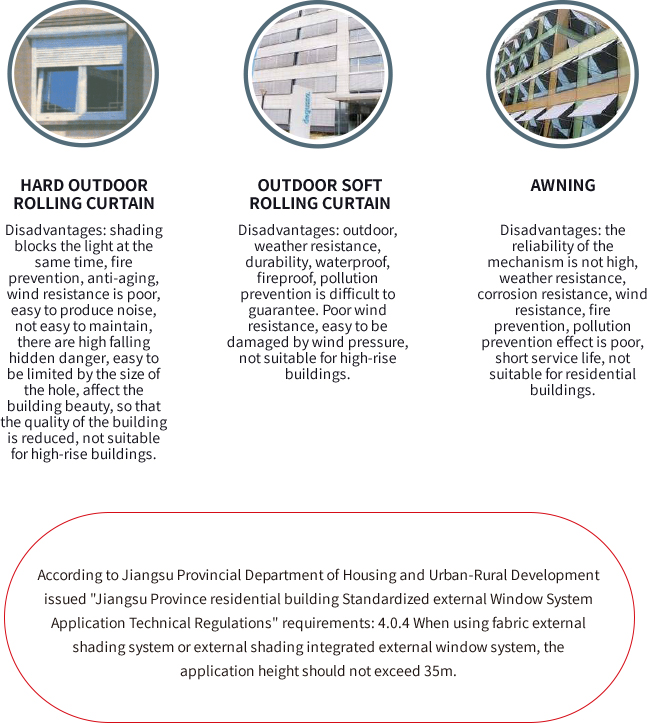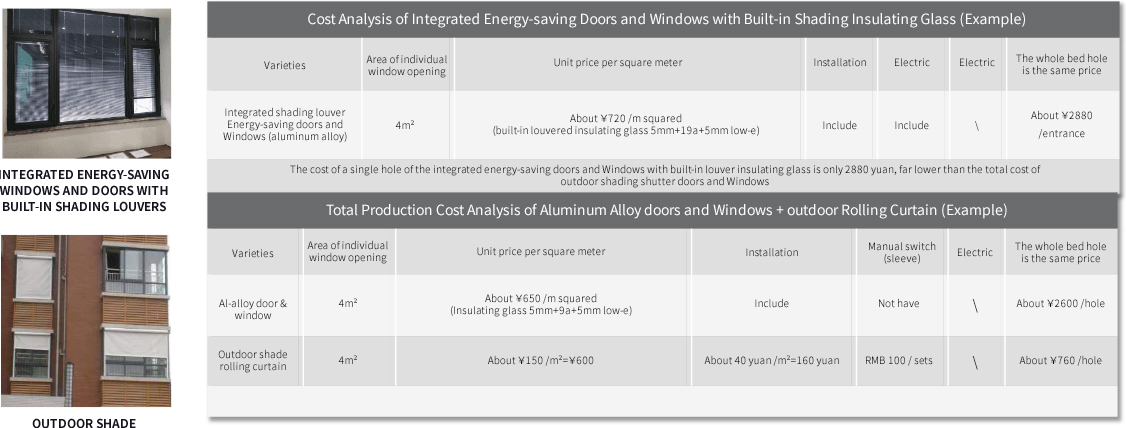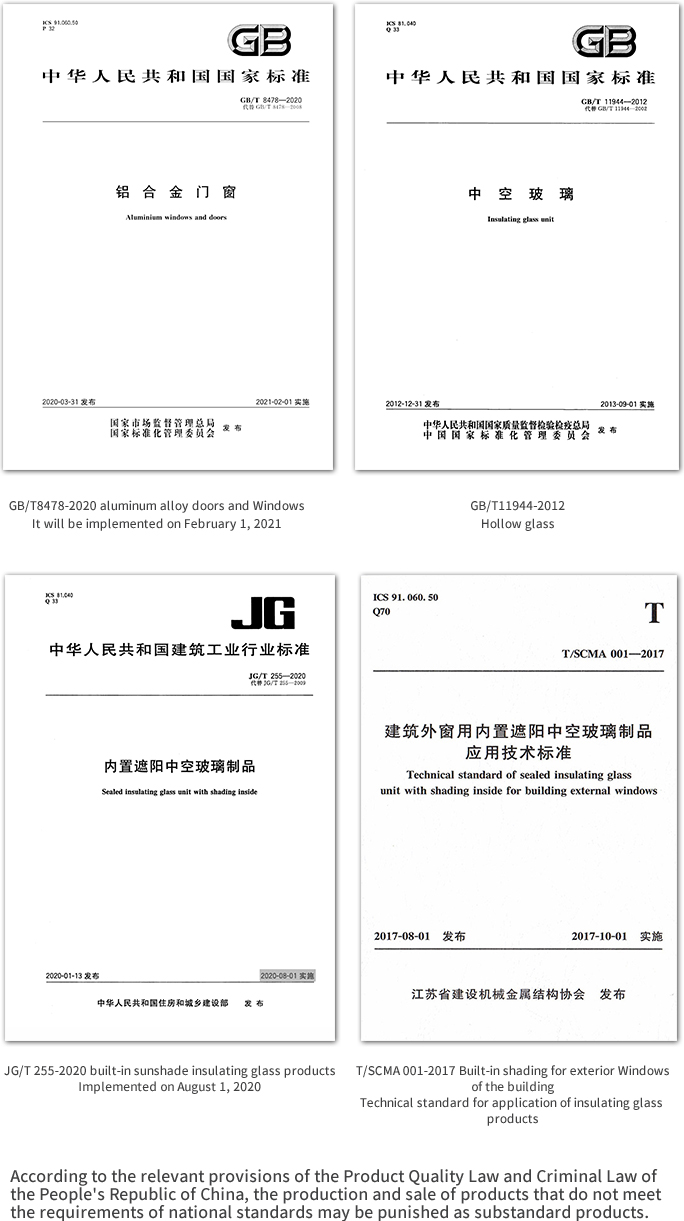Development trend of integrated energy-saving windows and doors with built-in sun shading louvers
The national standards related to building energy efficiency put forward new and higher requirements for the building sunshade industry. Building acceptance must meet the following standards and specifications:
一、GB50189-2015 in Design Standard for Energy Efficiency of Public Buildings
Sunshade measures shall be taken for exterior windows (including transparent curtain walls) facing buildings in hot summer and warm winter, hot summer and cold winter, and moderate areas.
The buildings in cold areas should adopt sunshade measures. When setting the external window, the following requirements shall be met:
(1) Movable external sunshade should be set in the east-west direction, and horizontal external sunshade should be set in the south direction;
(2) The sun shading device outside the building should give consideration to ventilation and winter sunshine.
二、Evaluation Standard for Green Buildings GB/T50378-2014
Take adjustable sunshade measures to reduce solar radiation heat gain in summer, and the total score is 12.
In the transparent parts of exterior windows and curtain walls, the proportion of areas with controllable sunshade adjustment measures reaches 25%; 6 points; If it reaches 50%, 12 points will be obtained.
三、Design Standard for Energy Efficiency of Residential Buildings in Hot Summer and Warm Winter Areas (JGJ75-2012)
The east and west outward windows of residential buildings must take external shading measures, and the external shading coefficient SC of the building shall not be greater than 0.8
According to the requirements of the standard:
The form and application of movable building shading is imperative!
(Data source network)
Modern buildings are an important part of energy consumption, and building energy conservation has become a very high social concern. With the continuous improvement of national policies and the continuous improvement of energy conservation requirements for civil and industrial buildings, it is required that doors and windows (accounting for more than 60% of the total building energy consumption) should be sunshaded and insulated in summer and heated and insulated in winter.
1.Heat transfer coefficient K value
①The whole window of energy door and window shall be less than 2.5w/(m2•k);
②Low energy consumption doors and windows shall be less than 2.0w/(m2•k);
③Ultra low energy consumption doors and windows shall be less than 1.5w/(m2•k);
④Near zero energy consumption doors and windows shall be less than 1.3w/(m2•k);
⑤Zero energy consumption doors and windows shall be less than 0.8w/(m2•k).
2.The shading coefficient SC shall be less than 0.3,
3.The visible light transmittance shall be greater than 0.65,
After repeated testing and verification, SDLD's built-in louver insulating glass can meet the three rigidity index requirements of the above national standards for building energy-saving doors and windows. It has also obtained the CABR energy-saving product certification of China Academy of Building Sciences, met the requirements of the Ministry of Housing and Urban Rural Development of the People's Republic of China that "energy-saving doors and windows should be integrated with sunshade products", won the "National Science and Technology Achievement Promotion Project in the Construction Industry" awarded by the Ministry of Housing and Urban Rural Development, and has been fully recognized by market and industry experts, and has gradually occupied a leading position in the domestic and foreign sunshade field.
Comparison of main forms, advantages and disadvantages of traditional external shading


Comparison of advantages and disadvantages between built-in sun shading hollow shutter and outdoor sun shading roller shutter

Technical characteristics of built-in louver insulating glass:
1. It is equipped with sunshade and heat insulation in summer, heating and heat insulation in winter, natural ventilation, wind resistance and noise reduction, convenient and safe maintenance while shading.
2. It has high integration of door and window shading, is not limited by the size of the opening, is anti-aging, fireproof, self-cleaning and anti pollution, and does not affect the beauty of the building.
The built-in louver insulating glass integrates sound, light and heat control functions, and is the first choice for thermal insulation doors and windows! It can perfectly realize the comprehensive effect of thermal insulation in winter and summer, regulating light and isolating noise; It is especially suitable for hot summer and cold winter areas with many typhoons.

Cost comparison of integrated energy-saving doors and windows with built-in sun shading shutters and outdoor sun shading roller shutters

Note: since the external sunshade roller shutter does not contribute to the heat transfer coefficient of the whole window after being closed, the doors and windows can only meet the same energy saving indicators as the built-in louver insulating glass by using three glass and two cavity insulating glass.
The conclusion of data comparison between the two tables: The use of high-quality integrated sun shading shutter energy-saving doors and windows is not only beautiful, practical, safe and convenient after sales service, but also can save at least 15% of the total cost of sun shading doors and windows in the whole project compared with the use of hand operated outdoor sun shading roller shutter (the cost of electric control is higher). Take a single hole as an example, the total cost can be saved!

Comparison of advantages and disadvantages between built-in sun shading hollow shutter and outdoor sun shading fabric soft roller shutter

Technical features of built-in louver insulating glass:
1.It is equipped with sunshade and heat insulation in summer, heating and heat insulation in winter, natural ventilation, wind resistance and noise reduction, convenient and safe maintenance while shading.
2.It has high integration of door and window shading, is not limited by the size of the opening, is anti-aging, fireproof, self-cleaning and anti pollution, and does not affect the beauty of the building.
The built-in louver insulating glass integrates sound, light and heat control functions, and is the first choice for thermal insulation doors and windows! It can perfectly realize the comprehensive effect of thermal insulation in winter and summer, regulating light and isolating noise; It is especially suitable for hot summer and cold winter areas with many typhoons.

Cost comparison of integrated energy-saving doors and windows with built-in sun shading shutters and outdoor sun shading fabric soft rolling shutters

Note: since the external sunshade roller shutter does not contribute to the heat transfer coefficient of the whole window after being closed, the doors and windows can only meet the same energy saving indicators as the built-in louver insulating glass by using three glass and two cavity insulating glass.
The conclusion of data comparison between the two tables: The use of high-quality integrated sun shading shutter energy-saving doors and windows is not only beautiful, practical, safe and convenient after sales service, but also can save at least 15% of the total cost of sun shading doors and windows in the whole project compared with the use of hand operated outdoor sun shading roller shutter (the cost of electric control is higher). Take a single hole as an example, the total cost can be saved!

The insulating glass products of built-in sun shade louver shall meet the following relevant standards


Aluminum Alloy Doors and Windows GB/T8478-2020
Interpretation of the national standard of built-in sunshade insulating glass


Insulated glass products for built-in sunshade JG/T255-2020
Interpretation of the national standard of built-in sunshade insulating glass


The following conclusions can be drawn:
· Door and window insulation and door and window insulation are two important components of building energy conservation;
· The thermal insulation of doors and windows is expressed in terms of heat transfer coefficient K (U value in EU and America);
· The thermal insulation of doors and windows is expressed in terms of the SHGC value of the sun (used in the United States and China), the total solar transmittance g value (used in the EU, ISO standards, and domestic ISO standards), or the shading coefficient SC value (currently being replaced). The SHGC value in China will completely replace the SC value;
·The SHGC values in summer and winter are required respectively, which is an important trend of building energy conservation in China in the future;
In this context, the form and application of movable building shading is imperative!




